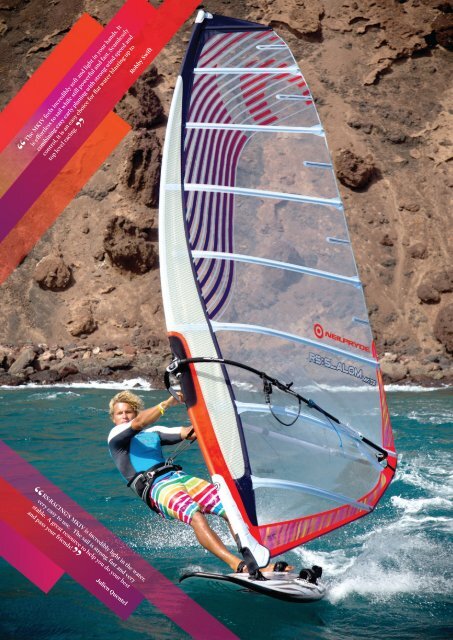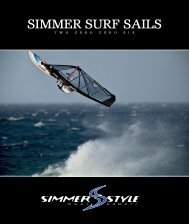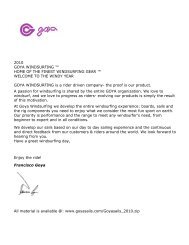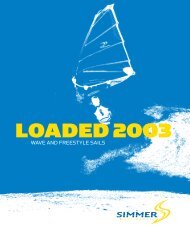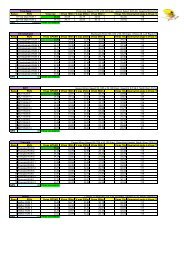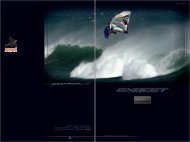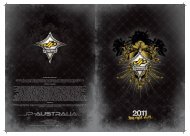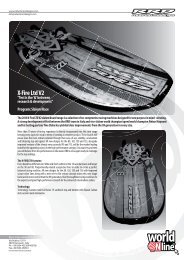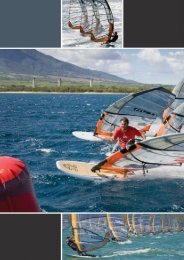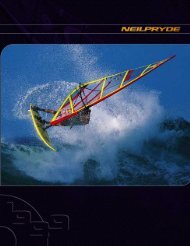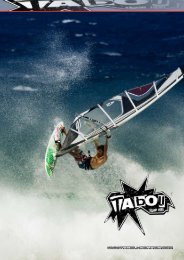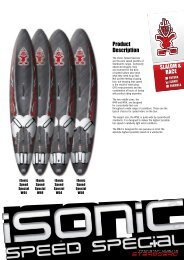RS:RACING'S MKIV is incredibly light in the water, very easy to use ...
RS:RACING'S MKIV is incredibly light in the water, very easy to use ...
RS:RACING'S MKIV is incredibly light in the water, very easy to use ...
You also want an ePaper? Increase the reach of your titles
YUMPU automatically turns print PDFs into web optimized ePapers that Google loves.
The <strong>MKIV</strong> feels <strong><strong>in</strong>credibly</strong> soft and <strong>light</strong> <strong>in</strong> your hands. It<br />
<strong>is</strong> effortless <strong>to</strong> sail while still powerful and fast. Seamlessly<br />
comb<strong>in</strong><strong>in</strong>g <strong>easy</strong> early plan<strong>in</strong>g with strong w<strong>in</strong>d speed and<br />
control, it <strong>is</strong> an <strong>easy</strong> choice for flat <strong>water</strong> blast<strong>in</strong>g up <strong>to</strong><br />
<strong>to</strong>p level rac<strong>in</strong>g.<br />
Robby Swift<br />
<strong>RS</strong>:RACING’S <strong>MKIV</strong> <strong>is</strong> <strong><strong>in</strong>credibly</strong> <strong>light</strong> <strong>in</strong> <strong>the</strong> <strong>water</strong>,<br />
<strong>very</strong> <strong>easy</strong> <strong>to</strong> <strong>use</strong>. The sail <strong>is</strong> strong, fast and <strong>very</strong><br />
stable. A great resource <strong>to</strong> help you do your best<br />
and pass your friends!<br />
Julien Quentel
Fast with Ease. Speed and Acceleration with Light Weight Feel<br />
RACING<br />
The <strong>RS</strong>:Slalom <strong>is</strong> designed <strong>to</strong> deliver, performance, ease of <strong>use</strong> and pure joy <strong>to</strong> <strong>the</strong> <strong>use</strong>r, th<strong>is</strong> <strong>is</strong><br />
fast with <strong>in</strong>credible low end acceleration and good high end speed.<br />
• Integrated compact clew - An <strong>in</strong>set clew with<br />
a cont<strong>in</strong>uous sail outl<strong>in</strong>e gives <strong>the</strong> best of both<br />
worlds.<br />
The <strong>in</strong>set clew <strong>in</strong>creases <strong>the</strong> sails stability,<br />
handl<strong>in</strong>g and w<strong>in</strong>d-range, while <strong>the</strong> cont<strong>in</strong>uous<br />
sail outl<strong>in</strong>e helps direct <strong>the</strong> tension where it<br />
needs <strong>to</strong> go, keep<strong>in</strong>g <strong>the</strong> mid leech stable and<br />
keep<strong>in</strong>g <strong>the</strong> foot tw<strong>is</strong>t <strong>to</strong> a m<strong>in</strong>imum <strong>in</strong>sur<strong>in</strong>g<br />
<strong>the</strong> sail <strong>is</strong> not spill<strong>in</strong>g power where you don’t<br />
want it <strong>to</strong> spill power.<br />
• Shorter luff length on middle and smaller sizes<br />
(8.6 and down) keep<strong>in</strong>g <strong>the</strong> center of effort low<br />
and stable <strong>in</strong> powered-up conditions. With <strong>the</strong><br />
9.5 rema<strong>in</strong><strong>in</strong>g close <strong>to</strong> <strong>the</strong> MKIII by keep<strong>in</strong>g <strong>the</strong><br />
boom relatively short <strong>to</strong> allow for <strong>easy</strong> handl<strong>in</strong>g.<br />
• The boom length has rema<strong>in</strong>ed <strong>very</strong> close <strong>to</strong><br />
<strong>the</strong> MKIII accept on <strong>the</strong> 8.6 and 9.5 where it<br />
has been decreased <strong>to</strong> improve handl<strong>in</strong>g of<br />
larger sizes.<br />
• Luff Curve: Increased <strong>in</strong> order <strong>to</strong> achieve higher<br />
body tension and <strong>in</strong>creased profile stability.<br />
• Clew Height: Higher for <strong>in</strong>creased mid leech<br />
support.<br />
• Shape compar<strong>is</strong>on: F<strong>in</strong>er shap<strong>in</strong>g on <strong>the</strong><br />
profile entry <strong>to</strong> reduce drag and upw<strong>in</strong>d<br />
performance comb<strong>in</strong>ed with <strong>in</strong>creased profile<br />
<strong>in</strong> <strong>the</strong> harness l<strong>in</strong>e area <strong>in</strong> order <strong>to</strong> keep lowend<br />
power and drive.<br />
SIZE LUFF BOOM BASE BATTENS CAMS WEIGHT IDEAL MAST TOP FINISHING CODE<br />
5.5<br />
6.2<br />
7.0<br />
7.8<br />
8.6<br />
9.5<br />
TBC TBC TBC TBC TBC TBC TBC TBC BNP<strong>RS</strong>S455<br />
TBC TBC TBC TBC TBC TBC TBC TBC BNP<strong>RS</strong>S462<br />
TBC TBC TBC TBC TBC TBC TBC TBC BNP<strong>RS</strong>S470<br />
TBC TBC TBC TBC TBC TBC TBC TBC BNP<strong>RS</strong>S478<br />
TBC TBC TBC TBC TBC TBC TBC TBC BNP<strong>RS</strong>S486<br />
TBC TBC TBC TBC TBC TBC TBC TBC BNP<strong>RS</strong>S495<br />
24B
The new Integrated Compact Clew on <strong>the</strong> EVOIII <strong>is</strong> ano<strong>the</strong>r<br />
revolution <strong>in</strong> <strong>the</strong> long l<strong>in</strong>e of race sail revolutions from<br />
Neil Pryde!! The added control and stability that th<strong>is</strong> adds<br />
translates directly <strong>in</strong><strong>to</strong> higher speeds and more comfortable<br />
sail<strong>in</strong>g on <strong>the</strong> race course. I absolutely Love IT!!!!<br />
Micah Buzian<strong>is</strong><br />
I enjoy sail<strong>in</strong>g <strong>the</strong> new EVOIII - it <strong>is</strong> simply <strong>the</strong> best sail out <strong>the</strong>re<br />
on <strong>the</strong> market so give it a try and get <strong>in</strong> on <strong>the</strong> action! I love <strong>the</strong> way<br />
it handles, it gives me power when I need it and <strong>is</strong> <strong>easy</strong> <strong>to</strong> manage<br />
even <strong>in</strong> <strong>light</strong>er conditions. I can just rig up and get out on <strong>the</strong> <strong>water</strong>,<br />
no time wasted and performance guaranteed.<br />
An<strong>to</strong><strong>in</strong>e Albeau
Pure Race – No comprom<strong>is</strong>es – The only clear goal…<strong>to</strong> w<strong>in</strong>!<br />
RACING<br />
Look<strong>in</strong>g for performance, you are look<strong>in</strong>g at <strong>the</strong> right sail. Th<strong>is</strong> <strong>is</strong> a full breed rac<strong>in</strong>g sail.<br />
• Integrated compact clew - An <strong>in</strong>set clew with<br />
a cont<strong>in</strong>uous sail outl<strong>in</strong>e gives <strong>the</strong> best of both<br />
worlds.<br />
The <strong>in</strong>set clew <strong>in</strong>creases <strong>the</strong> sails stability,<br />
handl<strong>in</strong>g and w<strong>in</strong>d-range, while <strong>the</strong> cont<strong>in</strong>uous<br />
sail outl<strong>in</strong>e helps direct <strong>the</strong> tension where it<br />
needs <strong>to</strong> go, keep<strong>in</strong>g <strong>the</strong> mid leech stable and<br />
keep<strong>in</strong>g <strong>the</strong> foot tw<strong>is</strong>t <strong>to</strong> a m<strong>in</strong>imum <strong>in</strong>sur<strong>in</strong>g<br />
<strong>the</strong> sail <strong>is</strong> not spill<strong>in</strong>g power where you don’t<br />
want it <strong>to</strong> spill power.<br />
• Shorter luff length on middle and smaller sizes<br />
(8.6 and down) keep<strong>in</strong>g <strong>the</strong> center of effort low<br />
and stable <strong>in</strong> powered-up conditions. With <strong>the</strong><br />
9.5 rema<strong>in</strong><strong>in</strong>g close <strong>to</strong> Evo2 keep<strong>in</strong>g <strong>the</strong> boom<br />
relatively short, critical when sail<strong>in</strong>g around <strong>the</strong><br />
slalom course. On Formula sizes <strong>the</strong> luff length<br />
<strong>in</strong>creased compared <strong>to</strong> Evo2 by decreas<strong>in</strong>g<br />
<strong>the</strong> head size without <strong>in</strong>creas<strong>in</strong>g boom length,<br />
result<strong>in</strong>g <strong>in</strong> improved upw<strong>in</strong>d performance.<br />
• Boom length rema<strong>in</strong>es <strong>very</strong> close <strong>to</strong> <strong>the</strong> EvoII<br />
except on <strong>the</strong> 8.6 and 9.5 where it has been<br />
decreased <strong>to</strong> improve handl<strong>in</strong>g of <strong>the</strong> sails<br />
around <strong>the</strong> course.<br />
• Luff Curve: Increased <strong>in</strong> order <strong>to</strong> achieve higher<br />
body tension, <strong>in</strong>creased response and improved<br />
profile stability.<br />
• Clew Height: Higher for <strong>in</strong>creased mid leech<br />
support.<br />
• Shape compar<strong>is</strong>on: F<strong>in</strong>er shap<strong>in</strong>g on <strong>the</strong> profile<br />
entry <strong>to</strong> reduce drag and <strong>in</strong>crease upw<strong>in</strong>d<br />
performance comb<strong>in</strong>ed with <strong>in</strong>creased profile <strong>in</strong><br />
<strong>the</strong> harness l<strong>in</strong>e area <strong>in</strong> order <strong>to</strong> keep low-end<br />
power and drive.<br />
SIZE LUFF BOOM BASE BATTENS CAMS WEIGHT IDEAL MAST TOP FINISHING CODE<br />
5.5<br />
6.2<br />
7.0<br />
7.8<br />
8.6<br />
9.5<br />
10.0<br />
10.7<br />
12.0<br />
399 181 30 7 4 5.40 370 TBC BNP<strong>RS</strong>55E3<br />
423 191 24 7 4 5.60 400 TBC BNP<strong>RS</strong>62E3<br />
451 201 22 7 4 5.80 430 TBC BNP<strong>RS</strong>70E3<br />
476 211 16 7 4 6.20 460 TBC BNP<strong>RS</strong>78E3<br />
500 220 10 7 4 6.40 490 TBC BNP<strong>RS</strong>86E3<br />
526 230 36 7 4 6.78 490 TBC BNP<strong>RS</strong>95E3<br />
TBC TBC TBC TBC TBC TBC TBC TBC BNP<strong>RS</strong>00E3<br />
TBC TBC TBC TBC TBC TBC TBC TBC BNP<strong>RS</strong>10E3<br />
TBC TBC TBC TBC TBC TBC TBC TBC BNP<strong>RS</strong>12E3<br />
24D
TECHNOLOGY<br />
DESIGN FEATURES<br />
1. Flexhead configuration<br />
Light weight f<strong>in</strong><strong>is</strong>h<strong>in</strong>g of <strong>the</strong> head of <strong>the</strong> sail for optimum leech response.<br />
2. Fully tubular batten construction<br />
Three-piece batten construction reduces weight of <strong>the</strong> sail while <strong>in</strong>creas<strong>in</strong>g leech reflex.<br />
3. Component luff pocket construction<br />
The luff pocket construction features a low friction material <strong>in</strong> <strong>the</strong> cam area, facilitat<strong>in</strong>g easier<br />
rotation. Stiffer material <strong>use</strong>d <strong>in</strong> <strong>the</strong> upper luff-pocket reduces sail weight while stabiliz<strong>in</strong>g sail<br />
entry and tw<strong>is</strong>t.<br />
4. Aerodynamic boom cu<strong>to</strong>ut closure<br />
Prevents <strong>the</strong> apparent w<strong>in</strong>d from blow<strong>in</strong>g <strong>in</strong><strong>to</strong> <strong>the</strong> mast sleeve and generat<strong>in</strong>g drag.<br />
5. Dynamic Luff sleve shap<strong>in</strong>g<br />
a) Increas<strong>in</strong>g <strong>the</strong> width of <strong>the</strong> double surface lead<strong>in</strong>g edge <strong>in</strong> <strong>the</strong> area where <strong>the</strong> profile <strong>is</strong> <strong>the</strong><br />
deepest, i.e. <strong>in</strong> front of <strong>the</strong> rider, helps <strong>to</strong> keep <strong>the</strong> draft stable <strong>in</strong> th<strong>is</strong> critical area.<br />
b) Decreas<strong>in</strong>g <strong>the</strong> width of <strong>the</strong> double luff <strong>in</strong> <strong>the</strong> head allows <strong>the</strong> sail <strong>to</strong> tw<strong>is</strong>t off more smoothly<br />
and under less load. Th<strong>is</strong> reduces tension on <strong>the</strong> leech.<br />
6. Compact Outl<strong>in</strong>e - Reduced luff length<br />
Compact aspect ratio sails reta<strong>in</strong> high levels of control and handl<strong>in</strong>g as <strong>the</strong> area rema<strong>in</strong>s low <strong>in</strong><br />
<strong>the</strong> sail, where <strong>the</strong> sailor has more control over it.<br />
KEY FEATURES<br />
1. Rigs easily and rotates well.<br />
2. Easy <strong>to</strong> <strong>use</strong> rac<strong>in</strong>g sail.<br />
3. Features <strong>the</strong> new Integrated Compact Clew – a new <strong>in</strong>novation <strong>in</strong> design.<br />
4. Incredible low end acceleration and good high end speed.<br />
5. As close as possible <strong>to</strong> <strong>the</strong> <strong>RS</strong>: Rac<strong>in</strong>g EVOIII’s performance with less cams and reduced weight<br />
for <strong>easy</strong> handl<strong>in</strong>g.<br />
1. NeilPryde rac<strong>in</strong>g technology, proven <strong>to</strong> provide w<strong>in</strong>n<strong>in</strong>g sails for <strong>the</strong> last decade.<br />
2. An<strong>to</strong><strong>in</strong>e Albeau’s sail of choice for Slalom, Speed, Formula and Long D<strong>is</strong>tance.<br />
3. Features <strong>the</strong> new Integrated Compact Clew – a new <strong>in</strong>novation <strong>in</strong> design.<br />
4. Performs <strong>in</strong> an even bigger w<strong>in</strong>d range than <strong>the</strong> EVOII.<br />
5. Designed for unmatched <strong>to</strong>p speed and acceleration.<br />
25A
TECHNOLOGY<br />
RIGGING INSTRUCTIONS<br />
RACING<br />
Downhaul - Th<strong>is</strong> <strong>is</strong> <strong>the</strong> most critical aspect of <strong>the</strong> Rac<strong>in</strong>g sails, as with any rac<strong>in</strong>g sail th<strong>is</strong> <strong>is</strong> where<br />
<strong>the</strong> real speed and control come from. We at NPDC take great time <strong>in</strong> gett<strong>in</strong>g <strong>the</strong> rigg<strong>in</strong>g specs<br />
exactly right and th<strong>is</strong> <strong>is</strong> a great place <strong>to</strong> start. Downhaul <strong>is</strong> also subject <strong>to</strong> personal preference but<br />
at m<strong>in</strong>imum you should set your mast and base <strong>to</strong> <strong>the</strong> spec and pull it so <strong>the</strong>re <strong>is</strong> about 1cm between<br />
<strong>the</strong> pulley on <strong>the</strong> sail and <strong>the</strong> pulley on <strong>the</strong> base. Then while sitt<strong>in</strong>g <strong>in</strong> <strong>the</strong> downhaul position lift <strong>the</strong><br />
leech and mast up off <strong>the</strong> ground and look at <strong>the</strong> tw<strong>is</strong>t <strong>in</strong> <strong>the</strong> sail, you want <strong>to</strong> see a <strong>very</strong> progressive<br />
fall<strong>in</strong>g of <strong>the</strong> leech from <strong>the</strong> boom <strong>to</strong> <strong>the</strong> <strong>to</strong>p of <strong>the</strong> sail and <strong>the</strong> <strong>to</strong>p 2-3 battens should be fall<strong>in</strong>g<br />
off enough so you can’t see <strong>the</strong> ends of <strong>the</strong> battens. Some of our <strong>to</strong>p racers like <strong>to</strong> put a little more<br />
downhaul on <strong>the</strong>ir Sails as <strong>the</strong>y <strong>use</strong> <strong>the</strong>m always <strong>very</strong> powered up. But th<strong>is</strong> downhaul sett<strong>in</strong>g <strong>is</strong> for all<br />
conditions, <strong>light</strong> and strong w<strong>in</strong>d, you want <strong>the</strong> tw<strong>is</strong>t <strong>in</strong> <strong>the</strong> sail always <strong>to</strong> be able <strong>to</strong> get <strong>the</strong> maximum<br />
speed out of it.<br />
Outhaul - With <strong>the</strong> outhaul I strongly recommend us<strong>in</strong>g an adjustable system as th<strong>is</strong> <strong>is</strong> where you<br />
will want <strong>to</strong> do a lot of tun<strong>in</strong>g depend<strong>in</strong>g on <strong>the</strong> w<strong>in</strong>d conditions. I suggest <strong>to</strong> set <strong>the</strong> boom one<br />
step longer than <strong>the</strong> recommended sett<strong>in</strong>g pr<strong>in</strong>ted on <strong>the</strong> sail. Th<strong>is</strong> will give you a larger range of<br />
adjustment options and will also help <strong>to</strong> improve <strong>the</strong> camber rotation allow<strong>in</strong>g <strong>the</strong> back of <strong>the</strong> sail<br />
<strong>to</strong> push out as <strong>the</strong> draft <strong>is</strong> rotat<strong>in</strong>g. The ideal sett<strong>in</strong>g <strong>is</strong> with <strong>the</strong> sail just <strong>to</strong>uch<strong>in</strong>g <strong>the</strong> boom at full<br />
power, as <strong>the</strong> w<strong>in</strong>d gets <strong>light</strong>er don’t be afraid <strong>to</strong> let <strong>the</strong> outhaul off even <strong>to</strong> <strong>the</strong> po<strong>in</strong>t where <strong>the</strong> sail<br />
<strong>is</strong> lay<strong>in</strong>g on <strong>the</strong> boom up <strong>to</strong> your harness l<strong>in</strong>es. Don’t over outhaul <strong>the</strong> sail as <strong>the</strong> w<strong>in</strong>d gets stronger,<br />
if you pull <strong>to</strong> much outhaul you can lose <strong>to</strong> much power caus<strong>in</strong>g <strong>the</strong> sail <strong>to</strong> be <strong>very</strong> twitchy. Th<strong>is</strong> loss<br />
of power can also ca<strong>use</strong> a loss of drive <strong>to</strong> your board which <strong>the</strong>n makes controll<strong>in</strong>g your board even<br />
more difficult.<br />
Batten tension - The batten tension relates directly <strong>to</strong> sail stability and camber rotation, you need <strong>to</strong><br />
f<strong>in</strong>d a balance that works well for you. Start<strong>in</strong>g with <strong>the</strong> bot<strong>to</strong>m batten put <strong>the</strong> most tension on th<strong>is</strong><br />
batten <strong>to</strong> give <strong>the</strong> added shape <strong>in</strong> <strong>the</strong> bot<strong>to</strong>m maximum stability. Gradually decrease <strong>the</strong> tension on<br />
<strong>the</strong> next two battens up by about 2-3 full turns of <strong>the</strong> batten adjustment. On <strong>the</strong> fourth batten from<br />
<strong>the</strong> bot<strong>to</strong>m give enough tension <strong>to</strong> just take <strong>the</strong> wr<strong>in</strong>kles out of <strong>the</strong> batten pocket. For <strong>the</strong> rema<strong>in</strong><strong>in</strong>g<br />
<strong>to</strong>p battens you want <strong>the</strong>m <strong>to</strong> have just enough batten tension so that <strong>the</strong> bat cam snaps shut. You<br />
need <strong>to</strong> be careful with <strong>the</strong>se battens though not <strong>to</strong> put <strong>to</strong> much tension on <strong>the</strong>m and add shape <strong>in</strong><strong>to</strong><br />
<strong>the</strong> sail, don’t worry about tension<strong>in</strong>g all <strong>the</strong> wr<strong>in</strong>kles out of <strong>the</strong> front of <strong>the</strong> batten pockets. Instead<br />
look at <strong>the</strong> batten pocket and make sure that it <strong>is</strong> flat from <strong>the</strong> lead<strong>in</strong>g edge <strong>to</strong> <strong>the</strong> leech and if you<br />
push on <strong>the</strong> batten it <strong>is</strong> static and doesn’t <strong>in</strong>duce shape.<br />
Tack strap - The tack strap tension also has a direct impact on sail stability and camber rotation but<br />
it also affects <strong>the</strong> softness of <strong>the</strong> sail. Apply strong tack strap tension for <strong>light</strong>er w<strong>in</strong>ds, th<strong>is</strong> generally<br />
means for <strong>the</strong> larger sails 7.0 and up and also applies <strong>in</strong> flatter <strong>water</strong>. For <strong>the</strong> smaller sails 6.2 and<br />
down less tack strap tension will make <strong>the</strong> sail softer and more forgiv<strong>in</strong>g which works well <strong>in</strong> rough<br />
<strong>water</strong>. The stronger <strong>the</strong> tack strap tension <strong>the</strong> stiffer <strong>the</strong> camber rotation will become, f<strong>in</strong>d a balance<br />
that works well for you and <strong>the</strong> conditions you are sail<strong>in</strong>g <strong>in</strong>.<br />
Note - Race sail tun<strong>in</strong>g <strong>is</strong> a <strong>very</strong> personal feel dictated by sail<strong>in</strong>g styles, boards and personal preference.<br />
Play with your gear and your tun<strong>in</strong>g sett<strong>in</strong>gs <strong>to</strong> f<strong>in</strong>d what <strong>is</strong> right for you. Even our <strong>to</strong>p level racers<br />
An<strong>to</strong><strong>in</strong>e, Micah, Pieter and Robby all tune <strong>the</strong>ir gear s<strong>light</strong>ly different <strong>to</strong> one ano<strong>the</strong>r.<br />
25B
TECHNOLOGY<br />
Integrated Compact Clew<br />
With <strong>the</strong> <strong>RS</strong>:RACING EVOIII and <strong>RS</strong>:SLALOM <strong>MKIV</strong> we <strong>in</strong>troduce <strong>the</strong> Integrated Compact Clew where, <strong>in</strong><br />
compar<strong>is</strong>on <strong>to</strong> <strong>the</strong> current Dynamic Compact Clew, we have elim<strong>in</strong>ated <strong>the</strong> cu<strong>to</strong>ut at <strong>the</strong> clew and connected <strong>the</strong> foot<br />
area with <strong>the</strong> leech by clos<strong>in</strong>g <strong>the</strong> sail beh<strong>in</strong>d <strong>the</strong> boom end.<br />
Draft movement <strong>in</strong> overpowered<br />
conditions without Integrated<br />
Compact Clew<br />
Draft movement <strong>in</strong><br />
overpowered conditions<br />
with Integrated Compact Clew<br />
improved<br />
tw<strong>is</strong>t<br />
repositioned<br />
clew<br />
M<strong>in</strong>i Batten<br />
The m<strong>in</strong>i batten just below <strong>the</strong> Integrated<br />
Compact Clew (ICC) <strong>is</strong> <strong>the</strong>re <strong>to</strong> keep <strong>the</strong><br />
back of <strong>the</strong> sail supported and <strong>to</strong> keep <strong>the</strong><br />
surface clean and smooth. The tension will go<br />
through <strong>the</strong> perimeter of <strong>the</strong> sail keep<strong>in</strong>g <strong>the</strong><br />
foot and mid-leech stable for <strong>in</strong>creased w<strong>in</strong>d<br />
range and performance.<br />
M<strong>in</strong>i Batten<br />
Closure System<br />
As with all new th<strong>in</strong>gs <strong>the</strong> compact clew comes with design challenges.<br />
One of <strong>the</strong> ma<strong>in</strong> objectives was <strong>to</strong> ensure <strong>the</strong> open<strong>in</strong>g <strong>in</strong> <strong>the</strong> sail aligns<br />
at <strong>the</strong> same designated place each time. After experiment<strong>in</strong>g we chose<br />
a simple and strong metal clasp, which <strong>is</strong> specifically designed <strong>to</strong><br />
provide prec<strong>is</strong>e alignment when <strong>in</strong> a closed position.<br />
We chose th<strong>is</strong> system for its strength, simplicity, low profile and quick<br />
releas<strong>in</strong>g ability but most importantly it will give <strong>the</strong> proper alignment<br />
each time <strong>the</strong> clasp <strong>is</strong> put <strong>to</strong>ge<strong>the</strong>r.<br />
With Integrated Compact Clew, where <strong>the</strong> clew <strong>is</strong> positioned forward<br />
from <strong>the</strong> trail<strong>in</strong>g edge, <strong>the</strong> profile beh<strong>in</strong>d <strong>the</strong> clew <strong>is</strong> able <strong>to</strong> tw<strong>is</strong>t off when<br />
w<strong>in</strong>d pressure <strong>in</strong>creases. The sail au<strong>to</strong>matically adjusts its shape and thus<br />
controls excessive power.<br />
low w<strong>in</strong>d<br />
clew<br />
high w<strong>in</strong>d<br />
In addition, it also creates an ‘S’ profile on <strong>the</strong> batten, effectively<br />
push<strong>in</strong>g <strong>the</strong> deepest profile po<strong>in</strong>t forward, prevent<strong>in</strong>g it from mov<strong>in</strong>g<br />
back while overpowered, or enabl<strong>in</strong>g <strong>to</strong> hold pressure and keep <strong>the</strong><br />
lower leech tight <strong>in</strong> <strong>light</strong> w<strong>in</strong>ds and while rid<strong>in</strong>g upw<strong>in</strong>d.<br />
I have been th<strong>in</strong>k<strong>in</strong>g about th<strong>is</strong> clew concept s<strong>in</strong>ce my time at ART. After <strong>the</strong> <strong>in</strong>troduction of <strong>the</strong> Compact Clew that came out on <strong>the</strong> <strong>RS</strong>5 at <strong>the</strong> end of 2004 I was<br />
hop<strong>in</strong>g <strong>to</strong> be able <strong>to</strong> take th<strong>is</strong> concept one step fur<strong>the</strong>r and <strong>use</strong> all <strong>the</strong> advantages of <strong>the</strong> Compact Clew without hav<strong>in</strong>g <strong>to</strong> comprom<strong>is</strong>e <strong>the</strong> outl<strong>in</strong>e of <strong>the</strong> sail.<br />
In compar<strong>is</strong>on <strong>to</strong> regular sails with a clew on <strong>the</strong> back edge of <strong>the</strong> profile <strong>the</strong> EVOIII and <strong>MKIV</strong> have all <strong>the</strong> benefits common with <strong>the</strong> Dynamic<br />
Compact Clew: improved lower leech tw<strong>is</strong>t and much reduced draft movement due <strong>to</strong> <strong>the</strong> lower leech ability <strong>to</strong> create reflex beh<strong>in</strong>d <strong>the</strong> boom which<br />
releases excessive power and effectively locks <strong>the</strong> draft forward.<br />
The real advantage of th<strong>is</strong> new concept <strong>is</strong> that <strong>the</strong>re <strong>is</strong> a tension connection between <strong>the</strong> foot edge and lower leech. Th<strong>is</strong> helps <strong>to</strong> keep <strong>the</strong> foot of <strong>the</strong><br />
sail from blow<strong>in</strong>g out <strong>in</strong> gusts and also makes <strong>the</strong> whole leech tw<strong>is</strong>t, harmonically, gett<strong>in</strong>g even more out of <strong>the</strong> advantages already associated with<br />
<strong>the</strong> regular and Dynamic Compact Clew. In addition, <strong>the</strong>re <strong>is</strong> <strong>the</strong> benefit of a cleaner sail outl<strong>in</strong>e, when compared <strong>to</strong> <strong>the</strong> Dynamic Compact Clew, and<br />
<strong>the</strong>refore better aerodynamics as it <strong>is</strong> not necessary <strong>to</strong> have a clew cu<strong>to</strong>ut.<br />
Robert Stroj<br />
NeilPryde Chief Designer<br />
25A
RACING


